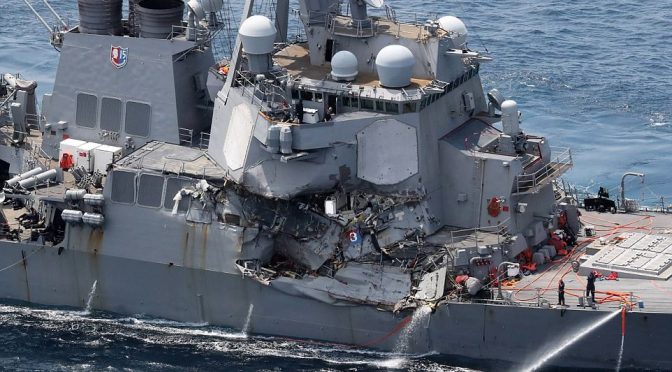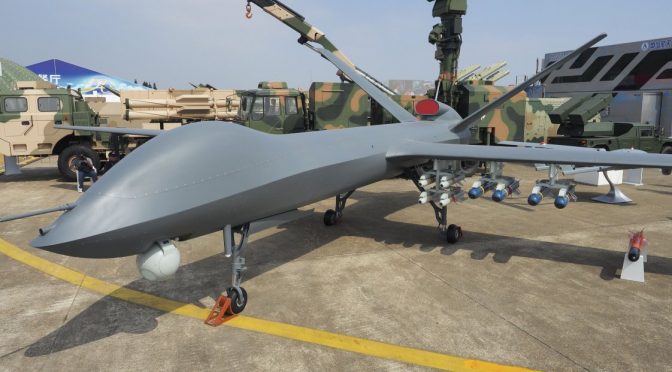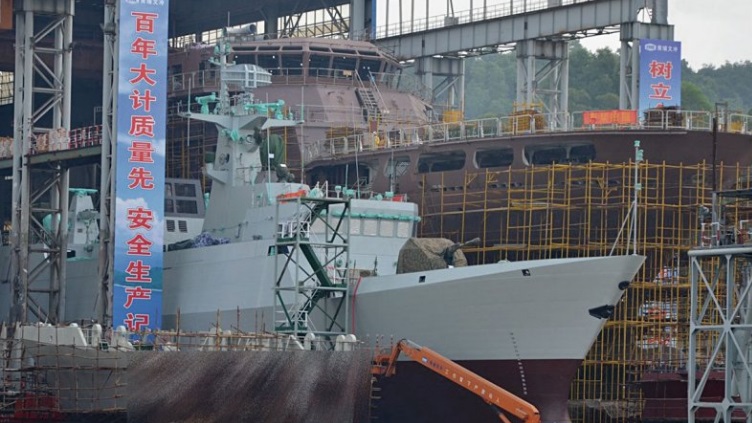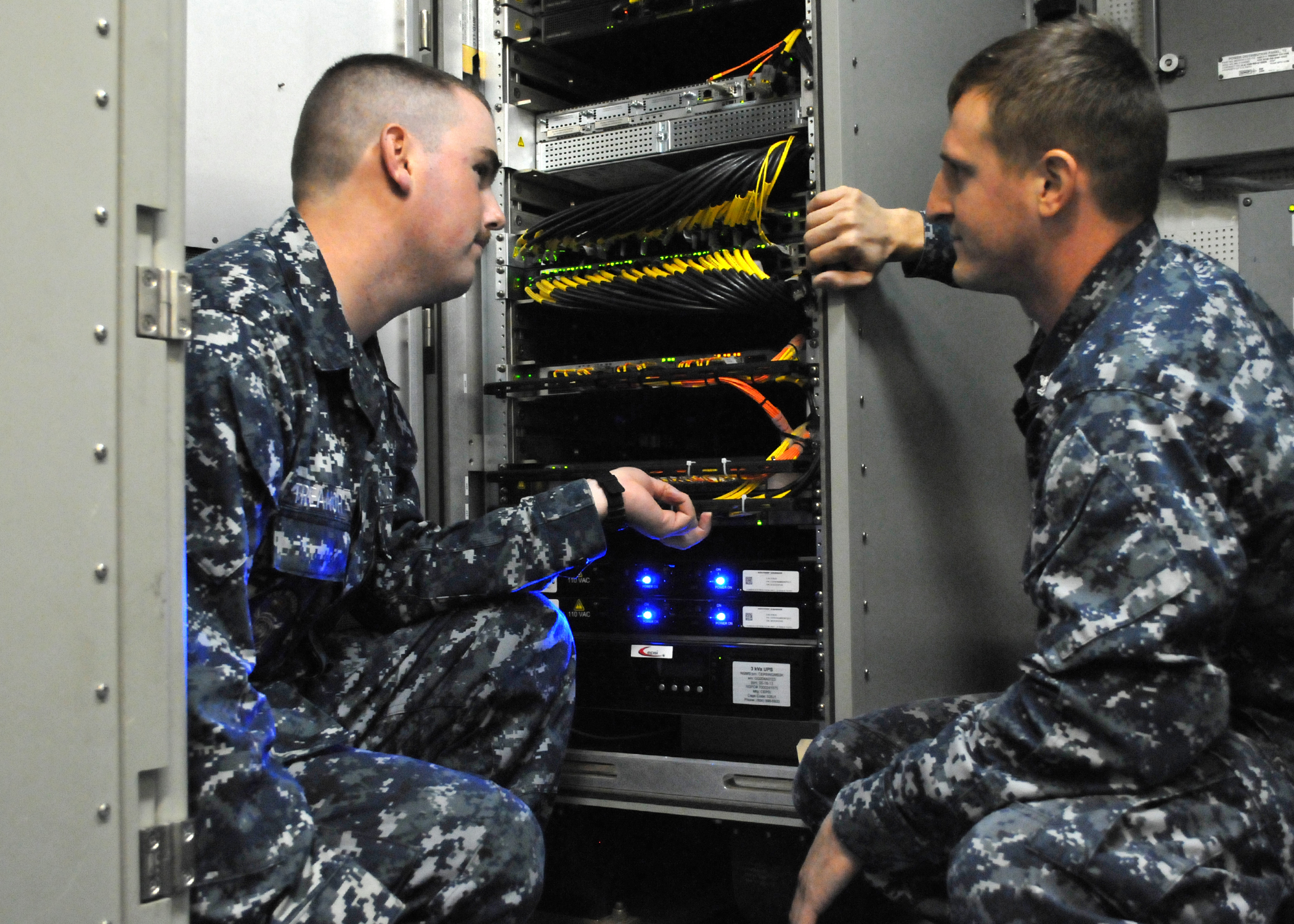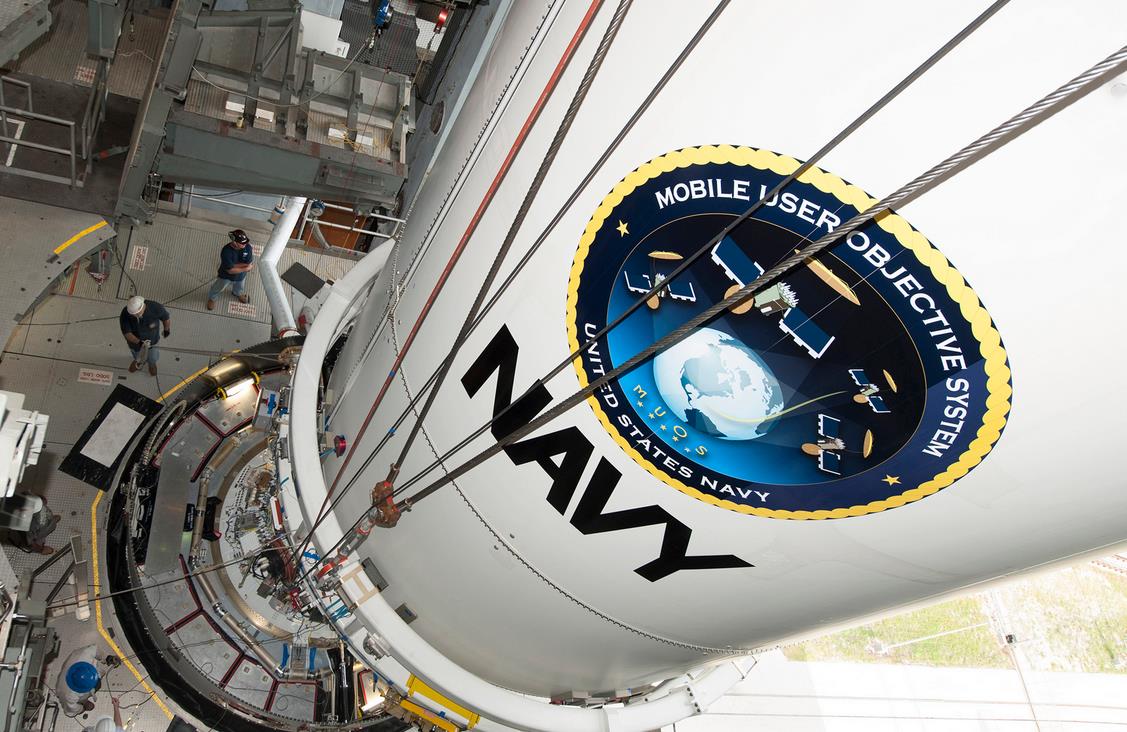By Chris Demchak, Keith Patton, and Sam J. Tangredi
These are exclusively the personal views of the authors and do not necessarily reflect the views of the U.S. Naval War College or the Department of Defense.
Security researchers do not believe in coincidences. In the past few weeks, a very rare event – a U.S. Navy destroyer colliding fatally with a huge commercial vessel – happened twice in a short period of time. These incidents followed a collision involving a cruiser off Korea and the grounding of a minesweeper off the Philippines, and have now resulted in the relief of a senior Seventh Fleet admiral. Surface warfare officers (SWOs) look to weather, sensors, watchstanders, training requirements, leadership and regulations (COLREGS) as possible contributing factors to the collisions.
Cyber security scholars, in contrast, first look to the underlying complex technologies trusted by the crew to determine the proper course of action. With the advancements in navigational technology, computer-aided decision making and digital connectivity, it is human nature that seafarers become more dependent on, as well as electronic aids for navigation and trusting the data the systems provide. While the U.S. Navy emphasizes verification of this data by visual and traditional navigation means, the reality is the social acceptance of the validity of electronic data is a feature of modern culture. The U.S. Navy, with an average age in the early 20s for sea-going sailors, is not immune from this effect. But what if the data is invalid or, as an extreme possibility, subject to outside manipulation?
In directing a pause for all warship crews (not currently conducting vital missions) during which to conduct assessments and additional training, the Chief of Naval Operations – Admiral John Richardson – was asked whether the Navy was considering cyber intrusion as a possible cause. The CNO responded that concerning cyberattack or intrusion, “the review will consider all possibilities.”
The truth could be that only mundane factors contributed to the accident, but as an intellectual thought experiment, what follows are explanations following the logic of open-source information. The first set of explanations will focus on the human in the loop to argue that the fundamental cause is likely human miscalculation rather than intentional distortion of data. The second explanation will focus on the criticality of accurate data provided to humans or their technologies. The pattern suggests a lack of ‘normalness’ as the ‘normal accidents’ of complex systems deeply integrated with cyber technologies – in frequency, locations, and effects. In the case of the destroyers, a credible case—based on analysis of land-based systems–could be made for a witting or unwitting insider introduction of malicious software into critical military navigation and steering systems. The conclusion will offer motivations for timing and targets, and some recommendations for the future.
Similarities in the Scenarios
There are similarities in recent collisions. Both happened in darkness or semi-darkness. Both happened in shipping lanes in which literally hundreds of major ships pass per day, to say nothing of smaller ships and fishing vessels. Crew manning of both vessels approach 300 sailors, with approximately one-eighth of the crew on watch involved in controlling/steering, navigating, as lookouts, and operating propulsion machinery when the ship is at its lowest states of alertness, known as peacetime steaming. It is logical that both ships were at peacetime steaming at the time since they were not conducting military exercises. In contrast, when USS JOHN S. McCAIN conducted a freedom of navigation operation (FONOP) in the vicinity of the artificial islands China has created to buttress its territorial claims to the South China Sea on August 9, her crew was likely at high alert.
In looking for possible explanations, we have downloaded and examined readily available open-source data concerning the two recent collisions, including identified locations of the incidents, vessel characteristics, crew manning, weather, proximity to land, automatic identification system (AIS) ship tracks, and shipping density data. We have consulted with naval experts on ship handling and on the Sea of Japan and Strait of Malacca.
Collision avoidance on Navy vessels can be roughly cast into four elements, three technical and one human. On the bridge, the watchstanders have (1) the AIS system which relies on tracking ships that broadcast their identities, (2) the military radar systems linked into the ships combat systems, (3)the civilian radar and contact management systems, and (4) the eyes of sailors standing watch on lookout normally posted port, starboard, and aft on the vessel. All these systems are complementary and overlapping, but not exactly delivering the same information.
The AIS system – in which merchant vessels transmit their identities and location data – is an open and voluntary system relying on GPS. In principle, keeping the AIS on is required for the 50 thousand plus commercial vessels over 500 GRT (gross registered tons). As of 2016, 87 percent of merchant shipping uses satellite navigation and 90 percent of the world’s trade is carried by sea. Nonetheless, ship captains can turn it off and travel without identifying themselves (at least until detected by other means). U.S. Navy vessels do not routinely transmit AIS but each bridge monitors the AIS of ships around them in addition to the military and civilian radar systems and the eyes of the sailors.
In quiet or tense times, the bridge watch and the Combat Information Center (CIC) teams of naval warships must synthesize this information and make sound decisions to avoid putting the ship into extremis. This is a continuous, round-the-clock requirement and a tough task for even the most skilled.

In contrast, merchant ships such as the Alnic MC, a chemical tanker (which hit JOHN S. McCAIN) have tiny crews with great reliance on autopilot. Depending on the circumstances, possibly only three people would be on the watch as the ship’s commercial navigation autonomously follows the route that the captain set initially. One of the indications that the ACX Crystal, the cargo vessel colliding with the USS FITZGERALD, was on autopilot was its behavior after the collision. Having been temporarily bumped off its course by the collision, it corrected and resumed steaming on the original course for about 15 minutes before stopping and turning to return to the collision location. While nothing is yet published about what was happening on either bridge in the June FITZGERALD collision, one can surmise that it took 15 minutes for the small crew to realize what had happened, to wrest control back of the behemoth, and turn it around.
Possible “Normal” Explanations
Flawed human decision-making
U.S. Navy warships maintain teams of watchstanders in order to mitigate the effects of a flawed decision being made by any one individual. Ultimately, one individual makes the final decision on what actions to take in an emergency—the Officer of the Deck (OOD) if the Commanding Officer is not available—but recommendations from the others are assumed to help in identifying flaws in precipitous decisions before they are actually made.
In contrast, in merchant ships with only two or three deck watchstanders, there is less of a possibility that flawed decision-making is identified before incorrect actions are taken. These actions can also be influenced by unrelated disorienting activities. Alcohol is not permitted on U.S. warships, abuse of drugs at any time is not countenanced, and U.S. naval personnel are subjected to random urinalysis as a means of enforcement. On a merchant ship these policies vary from owner to owner, and inebriation or decision-making under-the-influence has contributed to many past collisions.
Common tragedy from fatigue in an inherently dangerous environment
Collisions at sea happen. U.S. warships have collided with other warships, including aircraft carriers and with civilian vessels. USS FRANK EVANS was cut in half and sunk in 1969 when it turned the wrong way and crossed the bow of an Australian aircraft carrier. In 2012 the USS PORTER, a destroyer of the same class as the FITZGERALD and McCAIN, was transiting the Strait of Hormuz. The PORTER maneuvered to port (left) to attempt to get around contacts ahead of it, passing the bow of one freighter astern and then was hit by a supertanker it had not seen because it was screened behind the first freighter. Many of the previous collisions involved a loss of situational awareness by an at-least-partly fatigued crew. It is hard to avoid such conditions in an inherently dangerous, around-the-clock operating environment.
Mechanical Failure
There has been no report of a problem with the FITZGERALD prior to her collision. The Navy, however, has acknowledged the MCCAIN suffered a steering casualty prior to the collision. While backup steering exists in the form of manual controls in aft steering or using differential propulsion to twist the ship in the absence of rudder control, such control methods are not as efficient as the normal controls. Additionally, there would be a brief delay in switching control unexpectedly or transmitting orders to aft steering. In normal conditions, this would not be serious. In a busy shipping lane, with the least hesitation due to shock at the unexpected requirement, the brief delay could be catastrophic.
Quality of training for ship handling by young Surface Warfare Officers (SWOs)
One can look at the U.S. Navy Institute Proceedings (the premier independent naval journal) and other literature to see signs these incidents may be symptoms of a larger issue involving the training of watchstanders. In March 2017, LT Brendan Cordial had a Proceedings article entitled “Too Many SWOs per Ship” that questioned both the quality and quantity of the ship handling experience that surface warfare officers (SWOs) received during their first tours. Later in a SWO’s career track, the focus of new department heads (DH) is tactical and technical knowledge of the ship’s weapons systems and ship’s combat capabilities, not necessarily basic ship handling. Ship handling skill are assumed. But such skills can atrophy while these officers are deployed on land or elsewhere, and individual ships have unique handling characteristics that must be learned anew.
In January 2017, CAPT John Cordle (ret.) wrote an article for Proceedings titled “We Can Prevent Surface Mishaps” and called into question the modern SWO culture. Peacetime accident investigations rarely produce dramatic new lessons. They simply highlight past lessons. Errors in judgment, lapses in coordination, task saturation, fatigue, a small error cascading into a tragedy. Those who have stood the watch on the bridge or in the CIC read them, and frequently think, “There, but for the grace of God, go I.” However, unlike in the aviation community, near misses and accidents that almost happened were not publicly dissected and disseminated to other commands. Officers have always known how easy it is to be relieved for minor mishaps, but they do not have the community discussion of all those that nearly happened to learn vicariously from the experiences.
Pace of forward operations – especially for the MCCAIN after the FITZGERALD event
Both destroyers are homeported in Yokosuka, Japan, the headquarters of the U.S. Seventh Fleet. While only the line of duty investigation has been released for the FITZGERALD collision, one can assume that the officers and crew of the McCAIN would have heard some of the inside details from their squadron mate. Logically the CO of McCAIN would be doubly focused on the safe operation of his ship as he approached the highly congested traffic separation scheme (TSS) in the straits of Malacca and approach to Singapore harbor. But the loss of one of only seven similar and critical ships in a highly contested environment would almost certainly increased the tempo and demands on the MCCAIN as it attempted to move into the Singapore harbor just before sunrise.
In this case, tempo should have been accommodated adequately. While technology is a key component of U.S. warships, it is only one of many tools. Lookouts scan the horizon and report contacts to the bridge and CIC watch teams. The officer of the deck (OOD) uses their professional skills and seaman’s eye to judge the situation. If in doubt, they can, and should, call the Captain. Indeed, close contacts are required to be reported to the Captain. The bridge and CIC have redundant feeds to display contacts detected by radar, sonar, or AIS. The computer can perform target motion analysis, but crews are still trained to manually calculate closest points of approach and recommend courses to avoid contacts via maneuvering boards (MOBOARDs). This is done both on the bridge and in the CIC so even if one watch misses something critical, the other can catch it. When ships enter densely trafficked areas, additional specially qualified watchstanders are called up to augment the standard watch teams. Yet, it is possible that—under the theory of “normal” accidents—somewhere in this multiply redundant sensor system, misread or misheard information led to the human equivalent of the “telephone game” and the wrong choice was dictated to the helm.
But along with the “normal” explanations, the possibility of cyber or other intentional distortion of critical data does remain a possibility.
Cyber Misleads and Mis-function
If one argues that neither the Navy nor commercial crews were inebriated or otherwise neglectful, accepts that the weather and visibility were good for the time of day with crew in less stressful routine sailing postures, finds serendipitous mechanical failure of severe navigational significance on both ships difficult to accept as merely normal accidents, and questions if tempo distraction alone could explain both events, then – as Sherlock would say – the impossible could be possible. It is worth laying out using unclassified knowledge how cyber intrusions could have been used to cause warships to have collisions. This is not to say the collisions could not have multiple sources. But for the purposes of this thought experiment, however, this section will focus on cyber explanations.
Cyber affects outcomes because it is now a near universal substrate to all key societal and shipboard functions. Either cyber errors mislead humans, or its digitized operations malfunction in process, action, or effect, or both while buried inside the complex systems. To make this point, one of the two major classes of cyber assaults – the distributed denial of service (DDOS) – works by using what the computer wants to do anyway – answer queries – and simply massively overloads it into paralysis. It has been shown in a number of experiments that large mechanical systems integrated with electronics can be remotely made to overload, overheat, or vibrate erratically into breakdown by hackers or embedded malware. In several reports, the McCAIN may have suffered failures in both its main steering system (highly digitized) and its backup systems (more mechanical). Less information has been released on the earlier collision between the FITZGERALD and the ACX Crystal cargo ship so steering issues there cannot be known at this time.
However, that the two collisions involved large commercial ships with similar crews and technologies, and that two U.S. Navy vessels were sister ships close in age and technologies suggests commonalities that could be more easily exploited by adversaries using cyber means rather than humans. In particular, commonly shared logistics or non-weapon systems such as navigation are more likely to have vulnerabilities in their life cycles or embedded, routinized processes that are less sought by – or discernible to – the standard security reviews.
In a complex socio-technical-economic system like that involved in both circumstances, the one-off rogue event is likely the normal accident – i.e., the FITZGERALD incident. But too many common elements are present in the McCAIN event to suggest a second, simply rogue outcome. Hence, it is necessary to explore the three possible avenues by which the navigation could have been hacked without it being obvious to the U.S. Navy commander or crew in advance.
First, external signals (GPS, AIS) can be spoofed to feed both navigation systems with erroneous information for any number of reasons including adversary experimentation. Second, the civilian contact management systems on the civilian or military bridge (or both) could be hacked in ways either serendipitously or remotely engineered to feed erroneous data. Third, insider-enabled hacks of one or both of the destroyer’s combat systems could have occurred in the shared home port of Yokosuka to enable distortion of sensors or responses under a range of possible circumstances.
Spoofing GPS inputs to navigation
It does not take much technical expertise to spoof or distort GPS signals because the GPS system itself is sensitive to disruptions. The 2016 removal of one old satellite from service caused a 13.7 microsecond timing error that occurred across half of the 30-odd GPS satellites, causing failures and faults around the world in various industries. Anything that can be coded can be corrupted, even inadvertently. Anything so critical globally which does not have enforced, routine, and rigorous external validity tests, defenses, and corrective actions, however, is even more likely to attract the hacks from both state and nonstate actors.
Major national adversaries today have indicated interest in having the capability to arrange GPS distortions. With their already large domestic units of state-sponsored hackers, the Chinese, Russians, and North Koreans have already sought such capabilities as protections against the accuracy of largely U.S. missile guidance systems. Hacking GPS has been reported for some years, and while some efforts to harden the system have been pursued, spoofing mechanisms located on land in tight transit areas or even on other complicit or compromised vessels could mislead the autopilot. The website Maritime Executive reported mass GPS spoofing in June 2017 in the Black Sea, impacting a score of civilian vessels and putatively emanating from Russian sources most likely on land nearby.
However, it does not have to be a matter of state decision to go to war to have this kind of meddling with key navigation systems, especially if land or many other vessels are nearby. In a cybered conflict world, state-sponsored or freelance hackers would be interested in trying to see what happens just because they can. Not quite a perfect murder because of the external sources of data, however, the spoofed or spoiled data would provide misleading locations in real time to autopilot software. Vessels and their bridge would operate normally in their steering functions with bad data. They go aground or collide. So might airplanes. And the distorted signals could then stop, allowing normal GPS signals to resume and indicate that something went wrong in navigation choices but not in time to stop the collision or with the attribution trace necessary to know by whose hand.
In these two cases, the DDG FITZGERALD looks like it failed to give way to the ACX Crystal which appears by the tracking data to have been on autopilot. If the ACX Crystal’s navigation was operating on false data, and the equivalent civilian system on the U.S. ship was as well, then the watch team of the FITZGERALD would have had at least two other sources conflicting with the spoofed information – the military systems and the eyes of the sailors on watch. For the moment assume no deliberate hack of the military systems, its radars are correctly functioning, and the alert sailors have 20-20 vision, then the watch team of the FITZGERALD clearly miscalculated by believing the civilian system. Or, the overlap in relying on GPS is so profound that the military system was also fooled and the human eyes overruled. In that case, the FITZGERALD watch team trusted the civilian system over other inputs.
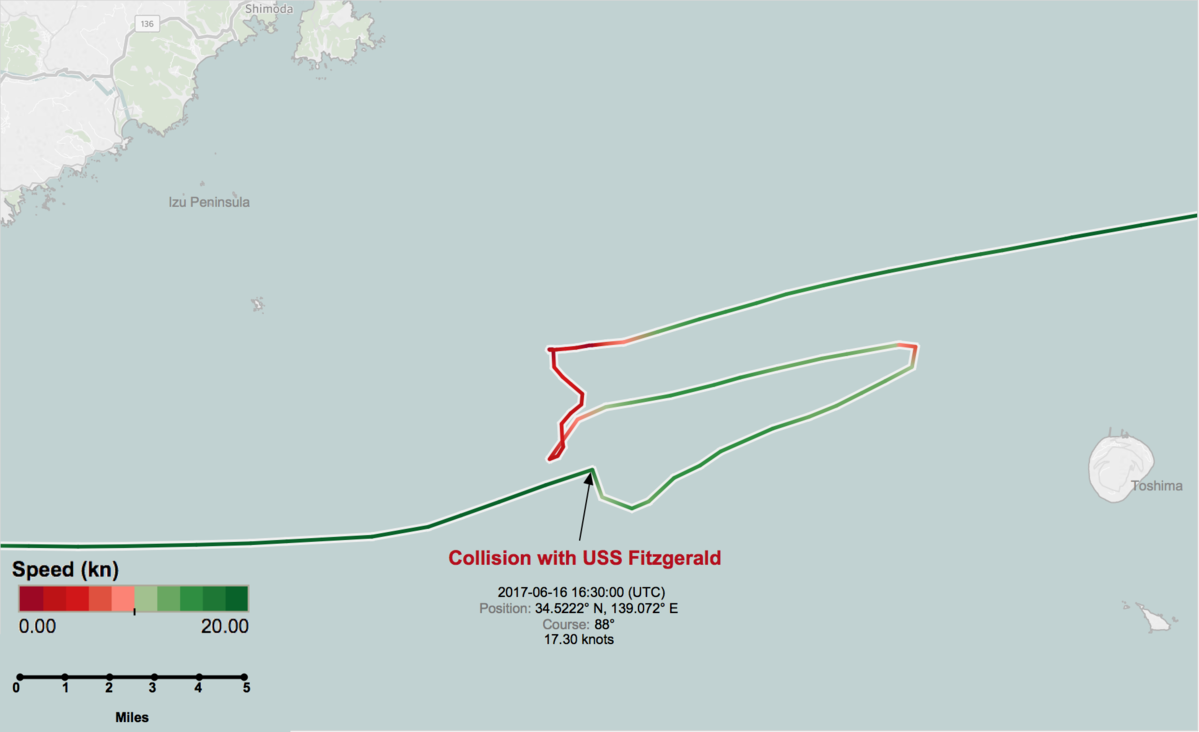
In the McCAIN case, if one assumes all the same conditions, the Navy ship had the right of way and the oil tanker plowed into it. Presumably the tanker autopilot – if it was on as one could reasonably assume – was coded to stop, divert, warn, and otherwise sound the alarm if it sees another ship in its path. Presumably, its code also embeds the right of way rules in the autopilot’s decision-making. A convincing GPS spoof could, of course, persuade the autopilot navigation that it is not where it was, thereby seeing more time and space between it and the Navy ship.
Hacking civilian navigation radars shared by all vessels
According to experts, commercial navigation systems are remarkably easy to hack quite apart from GPS spoofing. The cybersecurity of these bridge systems against deliberate manipulation has long been neglected. In the same unenforced vein as the voluntary identification requirement of AIS, the global maritime shipping industry has relied on requirements by maritime insurance companies and specific port regulations to control individual shipping firms’ choices in vessels technologies (and level of compliance). Myriad reports in recent years discuss the increasing sophistication of sea pirates in hacking commercial shipping systems to locate ships, cherry pick what cargo to go acquire, show up, take it, and vanish before anything can be done. That is more efficient than the old brute force taking of random ships for ransom.
In addition, shipping systems tend to be older and receive less maintenance – including time-critical patches – more likely to be scheduled with infrequent overall ship maintenance in port. In the recent “Wannacry” ransom-ware global event, the major shipping company Maersk – profoundly and expensively hit – reported its key systems used WIN XP unpatched and unsupported by Microsoft. Hacking groups are also targeting ports and their systems as well.
If systems are compromised, hacks could have opened back doors to external controllers or at least inputs when the commercial ship crossed into locations close enough to land or adversary-compromised surface or submerged vessels. Then the misleading inputs could be more closely controlled to be present when U.S. vessels have been observed to be traveling nearby or are in a particular position. Navy vessels may not transmit AIS, but they are detectable on radar as ships. A radar contact without an AIS identity could be a trigger for the malware to at least become interested in the unidentified vessel, perhaps sending pre-arranged signals to remote controllers to track and then wait for instructions or updates. The autopilot would then act on the inputs unaware of the distortion.
An interesting aspect of corrupting code is that exchanging data across commercial systems alone can provide a path for corrupted code to attempt to install itself on both ends of the data exchange. Stuxnet traveled through printer connections to systems otherwise not on any internet-enabled networks. If the civilian navigation systems are proprietary – and that is likely the case on commercial ships – then it is likely that the U.S. vessels’ bridges also have ‘hardened’ COTS civilian systems whose internal software and hardware are proprietary. That means a hack successful on the commercial side could open an opportunity to hack a similar or targeted civilian system that happens to be found on a U.S. Navy vessel. Furthermore, it is possible the two systems share vulnerabilities and/or have exchanges that are not visible to external observers.
Navy IT security on vessels might also regard the civilian proprietary systems as less a threat because they are not connected to internal military systems. They presumably are standalone and considered merely an additional navigation input along more trusted and hardened military systems. The commercial systems are (ironically) also less likely to be closely scrutinized internally, because that would mean the U.S. Navy is violating contractual rules regarding proprietary commercial equipment. Outside of war – in which such holds are likely to be ignored in crises – there is little incentive to violate those proprietary rules.
One can conceive of a Navy bridge hosting a commercial navigation system that at some point along its journey is compromised with nothing to indicate that compromise or the triggering of the software now interwoven with the legitimate firmware inside the equipment. By happenstance, the Navy vessel comes in to the vicinity of an appropriately compromised large commercial vessel. At that point, the adversary hackers might receive a message from the commercial vessel to indicate the contact and have the option to distort the navigation inputs to help the commercial vessel’s autopilot plow into the warship.
Of course the adversary is helped if the Navy equipment is also hacked and, perhaps, the vessel loses its digitized steering right before the impact.
Hacking U.S. Navy military navigation systems
Remotely accessing and then changing the triggers and sensors of military systems – if possible – would be very hard given the Navy’s efforts in recent years. That possibility is tough to evaluate because the open source knowledge regarding such systems is likely to be third party information on proprietary subordinate systems at least five or six years old – or much more. Both major U.S. adversaries in Asia – North Korea and China – already show propensities for long-term cyber campaigns to remotely gain access and infiltrate or exfiltrate data over time from all military systems, including shipborne navigation. We deem this less likely simply because this is where the cybersecurity focus of the Navy and DOD already is.
However, the history of poorly-coded embedded systems, lightweight or incompetent maintenance, and deep cyber security insensitivity of third party IT capital goods corporations is appalling across a myriad of industry supply chains, even without the national security implications well-known today. While commercial vessels could be hacked remotely, a more likely avenue for entry in Navy systems would be through these corrupted supply chains of third parties, shoddily constructed software, or compromised contractors creating or maintaining the ship’s navigation and related systems. Using insiders would be especially easier than remotely hacking inside when the vessels were in a trusted harbor nestled inside a long-term ally such as Japan. Using insiders to access the systems during routine activities would be less likely to be detected quickly, especially if the effects would not be triggered or felt until particular circumstances far from port and underway.
An especially oblivious contractor engaged in using specialized and proprietary software to patch, check, or upgrade equipment could inadvertently use compromised testing or patching tools to compromise the vessel’s equipment. For example, a Russian engineer carrying in a compromised USB stick was reportedly the originating source of the Stuxnet malware in Iran – whether he was witting or unwitting is unknown. The actions would have been the same. Furthermore, Navy systems are built by contractors with clearances of course, but the systems would have deeply buried and often proprietary inner operating code. Corrupted lines of code could rest inactive for some time, or be installed in the last minute, to lie dormant during most of the deployment until triggered. None would visibly display any corruption until the programmed conditions or triggers are present.
In hacked systems, triggers are really hard to discern in advance. In part, the skill of the adversary deftly obscures them, but also the objectives of adversaries can vary from the classic “act on command of national superiors,” to “see how far we can get and how,” to pure whimsy. With no real personal costs likely for any of these motives, the game is defined by the skill, patience, and will of the adversary, especially when proprietary commercial code is involved. While it is safer in terms of attribution for hackers to have more automatic triggers such as those used in the Stuxnet software, the action triggers do not have to be automatic. In navigation systems, data is exchanged constantly. Conceivably there can be a call out and return buried in massive flows of data.
Without extensive AI and rather advanced systems management, how massive data flows are monitored can vary widely. While it is more and more common to secure a system’s outgoing as well as incoming communication, a multitude of systems that are not particularly dated have been shown to allow rather subtle communications to go on for some time without any event or external revelation. One can imagine code calling home or acting autonomously when triggered by something as mundane as a sensor noting the presence of a large commercial cargo ship within X nautical miles, moving in Y direction, and responding to encrypted queries from its own navigation system. Highly skilled botnet masters are able to detect anomalies across thousands of infected computers and, in a pinch, de-install huge botnets in minutes. It is not difficult to imagine something buried in these otherwise secured systems, especially if the adversary is willing to wait and see when it would be useful. For North Korea, the latest ratcheting of tensions between the Hermit dictatorship and the U.S. could easily provide a reason.
Hacking seems more of a possibility when considering how both destroyers failed to navigate under circumstances that were, to most accounts, not that challenging. It is possible that the first such event – the FITZGERALD collision – was a rogue event, the kind of complex system surprise that routinely but rarely emerges. What is less likely is that a similar ship in broadly similar circumstances shortly thereafter proceeds to have a similar event. Exquisitely suspicious are the reports of the failure of the steering system and possibly its backups on McCAIN, though not on the FITZGERALD. That effect is not spoofed GPS or hacked civilian systems, and it would take much more reach of the malware to achieve. In keeping with the presumption here that a successful insider hack occurred on both ships and the malware was waiting for a trigger, the lack of steering failure (at least no reports of it) on the FITZGERALD could also mean the malware or external controller was smart enough to know collision did not need additional failures to ensure damage. The ship was already in the wrong place having failed to cede right of way. Holding fire like that would be desired and expresses sophistication. Typical technique in cybered conflict is deception in tools; adversaries do not burn their embedded hacks unless necessary. Once shown, the cyber mis-function becomes unusable again against an alert and skilled opponent such as the U.S. Navy.
Furthermore, the Aegis destroyers – of which both Navy vessels are – suffer from a rather massive knowledge asymmetry with a major adversary. At some point in the early to mid 2000s, the Chinese stole the entire design of the AEGIS systems on which the Navy spent billions across contractors and subcontractors. While built to roughly the same specifications as a class of ships, each vessel reflects the upgrades and systemic changes of its particular era, with the older 1990s ships like the FITZGERALD and McCAIN having more patches and bolt-ons than the newer versions of the ship. Fundamental ship elements are hardwired into the vessel and hard to upgrade, while more modular and likely proprietary modern systems are plugged in and pulled out as time goes on. The adversary who stole those comprehensive plans would know more about the older AEGIS ships than they would about the ships completed after the plans were stolen and newer systems used in the installs. Anyone who has ever faced the daunting prospect of rewiring a large house knows by ugly personal experience that the new wiring is forced to work around the existing layout and limitations. Ships are even more rigid and, quite often, the more critical the system, the less flexibly it can be changed.
Thus, vulnerabilities built into the highly complex earlier AEGIS systems would be both known to the thieves after some years of study and perhaps covert testing on other nations’ AEGIS systems, and be very hard to definitively fix by the Navy itself, especially if the service is not looking for the vulnerabilities. Unnerving, but not inconceivable, is the failure of the digitized steering system on the McCAIN – if it happened. Exceptionally telling, however, is the presumably near-simultaneously loss of backup systems. If the steering and contact management systems were compromised, steering could be made to fail at just the right time to force a collision. A good insider would be needed to ensure both, but only an adversary with considerable engineering design knowledge could reliably hazard a successful guess about how to disable the more likely mechanical backup systems. The adversary to whom the original AEGIS theft is attributed – China – is known to be very patient before using the material it has acquired.
Both Civilian and Military Systems
Why not put hacks on both systems? Commercial vessels are easier and could be left in place for some time pending being used and, in the meantime, slowly embedding Trojans via maintenance in port or third party access to remove and replace proprietary boxes or upgrades in software. Preparation of the cyber battlefield occurs – as does the ‘battle’ – in peacetime well before anything or anyone is blown up. China and North Korea have thousands of personnel on the offensive and value extraction cyber payroll. Careers could easily be made by such coups of installing such software as potential tools and have them still in place ready to be used months or years later.
Furthermore, Westerners are routinely afflicted with the rationality disease of believing that all actions – especially if adversaries are suspected – must be intentionally strategic and logically justifiable. Otherwise, why would the adversary bother? There is also a tendency to underestimate the comprehensive approach of most adversaries working against the U.S. Silence does not mean compliance or concession on the part of adversaries, especially not China or North Korea. Installing access points or triggers on all possible systems within one’s grasp is a basic long-term campaign strategy. Even now, when a major hack of a large corporation or agency is found, it has often been in place for years.
Motives for the Collisions
Timing may be serendipitous, but at least one adversary – North Korea – has already sunk a naval vessel of a U.S. ally, South Korea, with no public punishment. Certainly, North Korea has been loudly threatening the U.S. in the region and has cyber assets capable of what has been described above. However, one difficulty in determining culpability is that, while China is an ally of North Korea, neither will readily share information so valuable as the AEGIS design plans or even what each other may have hacked. One can readily ascribe eagerness to hurt the U.S. physically to North Korea, but attributing the same motivation to China at this point is problematic.
There are other possibilities, however. Both nations – like most nations – are led by individuals with little technical comprehension. In particular and most unfortunately, in a world of ubiquitous cybered conflict where ‘just because one can’ or ‘just to see what could happen’ operates equally well as a motivation, adversary states with a large army of hackers and technically ignorant superiors could easily have their own cyber wizards working in ways their superiors can neither discern nor realistically curtail. In this vein the McCAIN case (and possible FITZGERALD), these over eager technically skilled subordinates could have gotten quite lucky.
Why a DDG that happens to be sailing around Japan? Why one near Singapore? Why now? Well, “why not” is as good a reason, especially if the U.S. Navy publicly fires the ships’ leadership and declares the incidents over. In that case there are no consequences for adversaries. Perhaps the FITZGERALD was the rogue event, but—following that—the N.K. leaders then asked their wizards to take out another as signaling or retribution for recent U.S. “insults.” That motivation has some persuasive aspects: no publically apparent risks; a nifty experiment to see what can be done if needed in larger scale; and the public turmoil alone puts North Korea with a smug secret while the U.S. twists trying to figure it out. Cyber offensive capabilities in the hands of technically incompetent leaders have serious implications for misuse and, critically, inadvertent outcomes that are strategically more comprehensive and potentially destabilizing than ever intended.
Implications for the Navy
If it is leadership that failed in both cases, the Navy has a long history of responding and clearing out the incompetence. If it is cyber that undercut that leadership and killed sailors, the Navy has an uphill battle to definitively establish all the avenues by which it could have and did occur, including fully recognizing the multiple sources of such deliberately induced failure. The literature on complex large-scale system surprise and resilience offers means of preventing multisource failures in socio-technical systems. However, these means may not be compatible with current Naval thought and organization. The literature recommends parsing larger systems into self-sufficient and varying wholes that are embedded with redundancy in knowledge (not replication or standardization), slack in time (ability to buffer from inputs routinely), and constant trial and error learning. Trial and error learning is particularly hard because it routinely involves violations of current practices.
The current organization of the U.S. military seems incompatible with the concept of easily decomposable units engaging and disengaging as needed in collective sense-making. Neither can it accept constant systems adjustments, pre-coordinated but dynamically flexed rapid mitigation and innovation, and whole systems discovery trial and error learning. The truth is that in the cybered world, nothing can be trusted if it is not reliably verified by multiple, independent, and alternative sources of expertise. USS FITZGERALD did not discern its error and correct fast enough to avoid being in the wrong place at the wrong time. The McCAIN may have trusted its right of way entitlement too long, or made a traffic avoidance maneuver and suffered a steering casualty at the worst possible moment. Or perhaps both ships encountered something unexpected: a commercial ship operating on corrupted code. In the future, we should expect that any merchant ship controlled by digital information technology can be hacked.
This is a new idea for the Navy, that merchant shipping can be used as proxies for adversary intentions. With over 50,000 of such large vessels sailing around and next to U.S. ships all over the world, the adversary’s tools of coercion would be both effective and effectively obscured to visual or other indicators of malice. The world of cybered conflict is deeply riven with deception in tools and opaqueness in origins, and now it is clearly on the seas as well. Even if the Navy rules that both incidents were simply bad shiphandling, adversaries have already seen the great impact that can be had by making relatively fewer Navy ships collide with big, dumb, large commercial vessels. Even if cyber did not play the deciding role in these events, there is every reason to assume it will in the future. Just because they can try, they will.
Dr. Chris C. Demchak is the Rear Admiral Grace Murray Hopper Professor of Cybersecurity and Director of the Center for Cyber Conflict Studies, Strategic and Operational Research Department, Center for Naval Warfare Studies, U.S. Naval War College.
Commander Keith “Powder” Patton, USN, is a naval aviator and the former Deputy Director of the Strategic and Operational Research Department, Center for Naval Warfare Studies, U.S. Naval War College.
Dr. Sam J. Tangredi is professor of national, naval and maritime strategy and director of the Institute for Future Warfare Studies, Strategic and Operational Research Department, Center for Naval Warfare Studies, U.S. Naval War College.
Featured Image: Damage is seen on the guided missile destroyer USS Fitzgerald off Japan’s coast, after it collided with a Philippine-flagged container ship, on June 17, 2017 (AFP)

